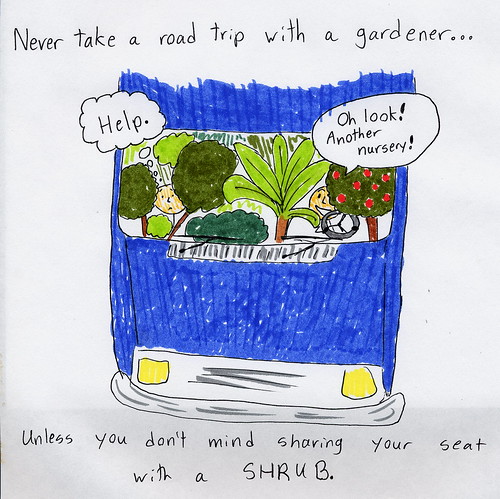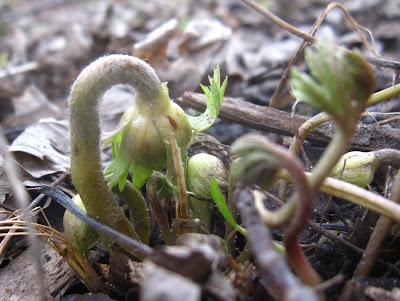As spring inches its way nearer, I've been figuring out all my plans for the garden this year. As usual, my seed shopping got a little out of hand, and I'm not going to have NEARLY enough ground for everything I want to grow. (Note to self: Next year, try to get interested in breeding plants that take up less room than corn and squash...)
Early last fall, I got busy preparing a bunch of new beds using my default method: sheet composting. I put down a layer of newspaper or cardboard and cover it with a nice layer of compost and then wood chip mulch. Done in the late summer or early fall, it nicely smothers the grass and weeds, and the newspaper breaks down, wormies get busy mixing loosening the soil, so that by spring you have a nicely mulched bed all ready to plant up.
But it takes time, and I need space, in a hurry, this spring. What's a fellow to do?
I used to turn to tillage. With a shovel, or a tiller, physically turning the soil over to kill the plants at the surface. It is how mankind has cleared land for farming and gardening practically since agriculture began but I've been rethinking that. Science has pretty clearly shown that tillage is pretty bad news, destroying soil structure, disrupting the vibrant and vital network of soil organisms, and making the soil vulnerable to erosion by wind and water – think the dust bowl. Now think how all that eroded soil effects life in the rivers and wetlands where it ends up. As a one-time event to prepare new ground, I don't think tillage it is a terrible option, but still, I'd rather avoid it if I can.
There are other options to clear soil for planting. You can cover the soil with clear plastic to trap the heat of the sun and bake out all the plants -- an option that doesn't really work in a cool, cloudy, Michigan spring, and I can't imagine is good for the soil biota anyway... If it is hot enough to kill plants, it has got to be hot enough to kill earthworms, beneficial bacteria and fungi. The same goes for boiling water (not to mention the distinct possibility of burning myself in the process...). And I'm not going to try the highly concentrated acetic acid (aka, vinegar) organic weed killers. I work with concentrated acetic acid in the lab. I wear goggles, gloves, and pour it in the fume hood. A little acetic acid is lovely for dressing a salad. A lot of acetic acid is incredibly caustic and will make you pretty unhappy if you spill it on yourself. Also not much good for the good things living in the soil. We use vinegar to preserve pickles because it kills bacteria and fungi. I'd rather not have pickled soil, thank you.
So, I wondered, what about glyphosate? The chemical you probably know as Round-Up, though it is off patent now, so there are oodles of cheaper, generic brand glyphosate-based herbicides on the market to choose from. I'm not generally one to be spraying stuff in the garden. If a plant has disease or insect problems, I rip it out and find something better to grow. When it comes to pesticides, it is pretty clear that not spraying anything is better environmentally than spraying something, but when it comes to preparing new ground, I'm not to sure. Which is less bad – tilling, or spraying glyphosate?
Glyphosate has some obvious advantages over tilling: less work, doesn't disrupt soil structure, leaves the soil covered and stabilized with dead leaves and roots to prevent erosion – but that could all be for naught if it does something wretched to the soil once it gets in there. So, I decided to do a little nosing through the scientific literature and see what I could find.
My first question was, is this stuff poison?
What I could find is that it is incredibly non-toxic. Essentially everything will kill you at high enough doses or if injected into the right part of your body, but glyphosate is pretty hard to do it with. There are a very few studies that find damage in very specific situations like embryos growing in petri dishes, but virtually everything will harm exposed cells in that situation. Based on what I can find, you should be more worried about everyday things like, say, shampoo.
Fish are something if a special case. Glyphosate itself is essentially harmless in water, and rapidly degraded by microorganisms in waterways. However, when it is made into products like Round-Up it is combined with surfactants -- essentially, soaps -- which break up water's surface tension and help it stick to leaves. These surfactants, applied directly to natural water ways, are not good for most of the things that live there. Don't let it drift onto your pond. But the same goes for your dish soap. Again, this stuff seems to be fairly harmless.
Glyphosate is, of course, highly toxic to plants, which is what it is supposed to be, but it pretty much has to contact leaves directly. Once it hits the soil, it is quickly bound up and inactivated by soil particles, and then degraded completely by soil organisms to nothing but CO2. Which is why you can spray one day and plant seeds the next and have no problems.
But what about earthworms and mycorrhizae, and all the other little good things that live in the soil? I'd not heard the topic discussed before, so I was very intrigued when I saw papers with titles like Effect of Glyphosate on Soil Microbial Activity and Biomass and Glyphosate toxicity and the effect of long-term vegetation control on soil microbial communities.
I was also very surprised by the findings. Adding glyphosate increases soil microbial activity. All the little bacteria and such are breaking it down, consuming it like they do compost or other soil organic matter. Long term there is essentially no effect: you add the glyphosate, there is a little burst of activity as it gets gobbled up, and then thing go back to normal. Even repeated applications over the long-term didn't change the make up of the soil biology.
At the end here, I'm left with the conclusion that glyphosate is a better bet ecologically than tilling. If I have the time, my first choice would always be sheet composting, but if I need ground cleared in a hurry, tillage has clear and well documented negative effects on soil and water quality, while glyphosate comes out looking much cleaner. It isn't the conclusion I expected to reach, but I think I will be using glyphosate to prepare my last minute beds this spring.















